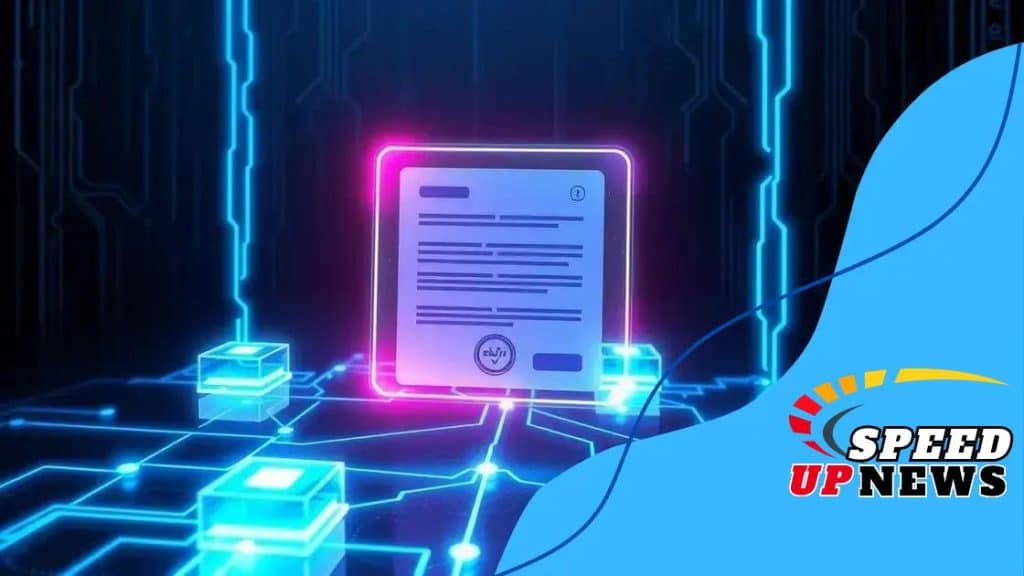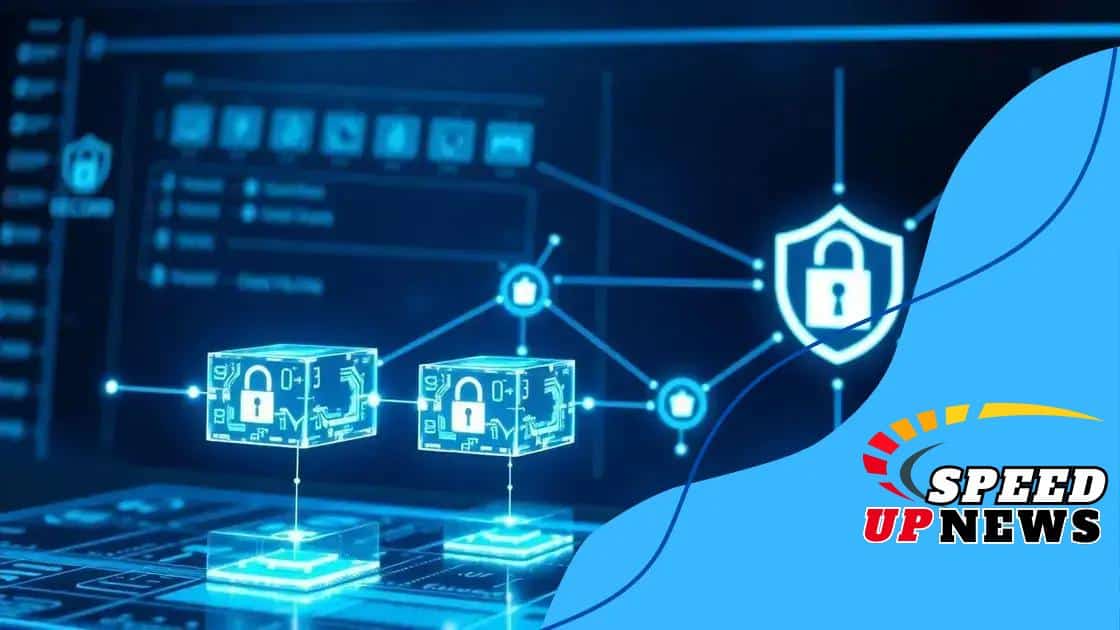Blockchain for academic records and certifications

Blockchain for academic records and certifications enhances security, streamlines verification processes, and supports lifelong learning by providing a decentralized, immutable ledger for tracking educational achievements.
Blockchain for academic records and certifications is transforming how institutions verify credentials. Imagine a world where diplomas are instantly verifiable, enhancing trust and transparency in education. Ready to learn how this technology can reshape the academic landscape?
Understanding blockchain technology
Understanding blockchain technology is crucial in today’s digital world. This innovative technology revolutionizes how we store and secure data. At its core, a blockchain is a distributed ledger that maintains a secure record of transactions across many computers.
Key Features of Blockchain
There are several significant features that define how blockchain technology operates:
- Decentralization: Unlike traditional databases, blockchain does not rely on a central authority. This reduces risks of failure and fraud.
- Transparency: Transactions on a blockchain are visible to all participants, ensuring a high level of transparency.
- Security: Advanced cryptography protects data within the blockchain, making it extremely secure against unauthorized access.
- Immutability: Once recorded, transactions cannot be altered, enhancing trust in the system.
As we dive deeper into the mechanics, it’s essential to note how blockchain technology operates through blocks. Each block contains multiple transactions. These blocks are linked together, forming a chain that strengthens the integrity of the data. When a new block is created, it must be verified by multiple sources, ensuring its accuracy.
How Blockchain Works
So, how does blockchain technology work in practice? When a transaction occurs, it’s grouped with other transactions into a block. This block is then transmitted across the network for verification. Once verified, it is added to the chain, which is distributed to all users on the network.
What makes this process fascinating is the consensus mechanism. This is the method by which all parties in the network agree on the validity of the transactions before adding them to the blockchain. There are different types of consensus algorithms, such as Proof of Work and Proof of Stake, each with its unique advantages.
With advancements in blockchain technology, various sectors are exploring its potential. Finance, healthcare, and education are just a few industries benefiting from its secure and transparent nature.
Benefits of blockchain in education
The benefits of blockchain in education are numerous and impactful. This technology introduces new ways to enhance transparency and security in academic records. Students and institutions alike can reap significant advantages.
Enhanced Security
One of the most notable benefits is enhanced security. Traditional methods of storing academic records are vulnerable to tampering and fraud. With blockchain technology, records are stored in a decentralized manner, making them far less susceptible to unauthorized changes.
- Immutable Records: Once a record is added to the blockchain, it cannot be altered. This feature ensures the integrity of educational credentials.
- Secure Verification: Employers and institutions can verify a candidate’s qualifications directly through the blockchain, reducing the chances of fraud.
- Data Privacy: Students maintain control over their records, deciding who can access their information.
Beyond security, blockchain in education facilitates easier access to credentials. Students no longer have to rely on paper copies of diplomas or degrees. Instead, they can share their verified records instantly. This instant access revolutionizes how students present their qualifications to potential employers.
Cost Savings and Efficiency
Another valuable aspect is the cost savings and efficiency improvements that blockchain offers. By streamlining the process of record keeping, institutions save on administrative costs. Traditional systems require significant resources to manage and maintain records.
The introduction of smart contracts, which can automate verification processes, further enhances efficiency. With these contracts, agreements are executed automatically when specific conditions are met, reducing delays and human error.
With the increasing demand for verified credentials in the job market, the need for reliable systems has never been greater. Embracing blockchain technology empowers educational institutions to meet these demands effectively.
How blockchain improves record keeping

Understanding how blockchain improves record keeping is vital as institutions look for more efficient ways to manage data. Traditional record-keeping systems can be prone to errors and fraud, but blockchain offers a secure and transparent alternative.
Eliminating Errors and Fraud
One major benefit of using blockchain technology for record keeping is its ability to eliminate errors. Each transaction recorded on a blockchain is verified by multiple participants before it is added. This verification process helps ensure accuracy and trustworthiness.
- Real-Time Updates: Changes can be tracked in real time, allowing for immediate corrections without disrupting the entire system.
- Protected from Tampering: Once records are added, they cannot be altered easily, which means they are secure from fraudulent changes.
- Audit Trails: Every transaction creates an audit trail that can be reviewed. This makes it easier to track the history of any record.
Moreover, the decentralized nature of blockchain means that no single entity has control over the records. This dispersal of power reduces the chance of data manipulation by any one party, making the system more reliable.
Streamlining Processes
Blockchain also streamlines record-keeping processes significantly. Instead of relying on outdated paper systems, institutions can store records digitally on a blockchain. This not only saves physical space but also enhances accessibility for authorized users.
With the integration of smart contracts, processes can be automated. For example, certain actions can trigger automatic updates to records without manual intervention, freeing up time for administrative staff. Students can get verifications of their academic achievements faster than ever.
As institutions adopt blockchain technology, they can expect to see improvements in efficiency and effectiveness in their record-keeping systems, paving the way for a more reliable and modern approach to managing information.
Real-world applications of blockchain certifications
Real-world applications of blockchain certifications are emerging across various industries. This technology is transforming how organizations verify qualifications and maintain trust in credentials.
Financial Sector
In the financial sector, blockchain certifications are used to create secure and verifiable records of transactions. For example, banks implement blockchain to provide enhanced security for identity verification processes. This helps prevent fraud and ensures that only valid transactions occur.
- Immediate Verification: Customers can access their records instantly for transactions.
- Reduced Costs: Organizations cut down on administrative costs by eliminating manual verification tasks.
- Enhanced Trust: Clients feel more secure knowing their data is protected and verifiable.
Furthermore, companies use blockchain to offer transparent and trustworthy services. By publishing certifications on a blockchain, they show clients their dedication to maintaining the highest standards.
Education Sector
In the education sector, blockchain certifications allow institutions to issue digital diplomas that can be easily verified by employers. This process simplifies credential verification for job seekers, enabling faster hiring decisions.
For instance, when a student graduates, their diploma is recorded on a blockchain. Employers can then check this record without needing to contact the institution directly, saving time and resources.
Additionally, students can control their own records, sharing them when and where they see fit. This empowerment supports their career advancements while preserving the privacy of their educational history.
Healthcare Sector
In healthcare, blockchain certifications play a vital role in keeping patient records secure and accessible. Medical professionals can verify credentials swiftly, which is crucial in emergencies.
For example, when new staff join a hospital, their professional qualifications can be checked through a blockchain ledger. This not only speeds up the hiring process but significantly reduces the risk of hiring unqualified individuals.
These applications illustrate just how versatile and impactful blockchain technology can be across multiple sectors, enhancing security, trust, and efficiency.
Future trends in blockchain for academics
Future trends in blockchain for academics hold exciting possibilities. As technology evolves, educational institutions are expected to adopt blockchain solutions to enhance academic records, improve transparency, and streamline processes.
Enhanced Interoperability
One significant trend is the development of enhanced interoperability between different blockchain systems. This means that academic records could be easily shared across various platforms. For example, a student could transfer records from one institution to another without hassle. These seamless transfers would simplify the enrollment process and ensure that institutions have access to accurate and verified student data.
- Standardized Formats: The creation of standard formats would facilitate easier exchanges of information across different systems.
- Interconnected Networks: Academic blocks could interconnect to provide a broader view of a student’s qualifications.
- Global Accessibility: Students worldwide could have their achievements recognized instantly.
Alongside interoperability, the rise of artificial intelligence in conjunction with blockchain technology will also play a vital role. AI can help analyze trends in educational data stored on a blockchain, allowing institutions to better understand student performance and tailor educational paths.
Increased Focus on Lifelong Learning
Another trend is the emphasis on lifelong learning. As the job market evolves, continuous education becomes more critical. Blockchain can help track all educational achievements, from formal degrees to short courses and certifications.
With a personal blockchain record, learners can showcase their skills and knowledge to potential employers in a verified manner. This digital portfolio would help bridge the gap between education and employment, making it easier for employers to assess candidates based on their continual learning journey.
As more people pursue online courses and alternative education paths, the demand for secure ways to verify credentials will rise. Blockchain technology can effectively address this need, creating a more transparent and efficient system for recognizing skills and accomplishments.
FAQ – Frequently Asked Questions about Blockchain in Academics
How can blockchain enhance the security of academic records?
Blockchain enhances the security of academic records by decentralizing data storage and making it nearly impossible to alter records without detection.
What benefits does blockchain offer for verifying educational credentials?
Blockchain allows for instant verification of educational credentials, reducing time and effort for both institutions and employers.
How does blockchain support lifelong learning?
Blockchain enables individuals to maintain a secure and accessible digital record of all their learning achievements, helping to showcase skills to employers.
What future trends should we expect in blockchain for academics?
Future trends include increased interoperability between systems, the rise of artificial intelligence for data analysis, and a focus on tracking lifelong learning.





